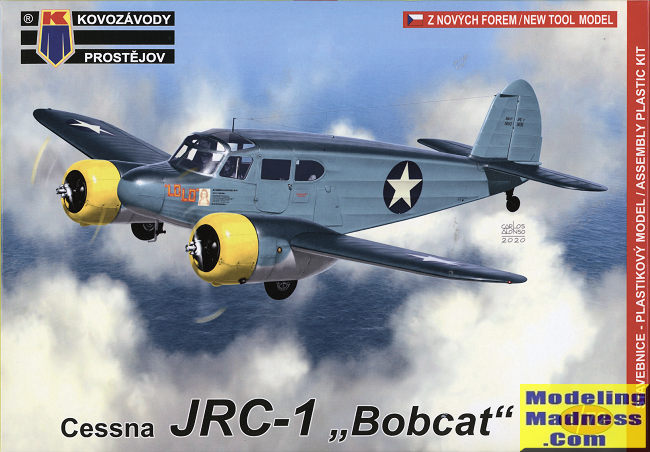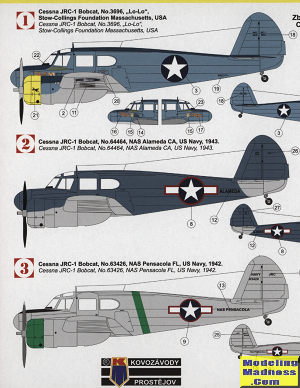
| KIT #: | KPM 0170 |
| PRICE: | $ 25.00 or so |
| DECALS: | Three options |
| REVIEWER: | Scott Van Aken |
| NOTES: | 2020 release |

| HISTORY |
In January 1934, Clyde Cessna as company president re-opened his Pawnee Road plant. Joining Cessna were his two nephews, Dwight Wallace as secretary-treasurer, and Dwane Wallace as plant manager. In 1935, Cessna sold out to his nephews, and retired on 8 October 1936. In 1939, the Cessna T-50 Bobcat made its maiden flight, becoming the company's first twin-engine, and retractable landing gear airplane. According to Walt Shiel, "Dwane Wallace, with a mere $5.03 in the corporate bank account, convinced the Royal Canadian Air Force (RCAF) the T-50 would be an ideal training aircraft for bomber pilots." Soon, hundreds of orders came in from the RCAF and the U.S. Army Air Corps.
The AT-17 was a military version of the commercial Cessna T-50 light transport. The Cessna Airplane Company first produced the wood and tubular steel, fabric-covered T-50 in 1939 for the civilian market, as a lightweight and low-cost twin for personal use where larger aircraft such as the Beech 18 would be too expensive. A low-wing cantilever monoplane, it featured retractable main landing gear and wing trailing edge flaps, both electrically actuated via chain-driven screws. The fully retracted main landing gear left half of the wheels extended below the engine nacelle for emergency wheel-up landings. The wing structure was built up of laminated spruce spar beams, truss-style spruce and plywood ribs, and plywood wing leading edges and wing tips. The fixed tailwheel is not steerable and full-swivelling, but can be locked into a fixed centered-orientation. The prototype T-50 made its maiden flight on 26 March 1939. The Curtiss Reed fixed-pitch propellers were then replaced with Hamilton Standard 2B-20-213 hydraulically-actuated, constant-speed, non-featherable propellers, while the 225-horsepower Jacobs L-4MB engines were rated at 245-horsepower for takeoff. Production began in December 1939 with over 5,400 built by the time production ended in 1944.
| THE KIT |
 This is another of KP's newer kits and
like all their new kits, comes in multiple boxings that differ only in the
decals they offer. This particular one is for the JRC-1 as operated by the
USN. The Navy only operated 67 of these so the markings options are all
fairly standard.
This is another of KP's newer kits and
like all their new kits, comes in multiple boxings that differ only in the
decals they offer. This particular one is for the JRC-1 as operated by the
USN. The Navy only operated 67 of these so the markings options are all
fairly standard.
There are two nicely molded grey sprues and one for the clear bits. Interestingly, the instructions have you start with the wings and the installation of the landing gear. This is because there are no main gear doors, the landing gear only partially retracting in flight. Nacelles are separate two piece items as are the engine cowlings. Engines look pretty nice, though you could probably spruce them up if you wished.
It isn't until step six that the
interior is built up. For this there are two main seats and a rear bench
seat that is part of the bulkhead. No control wheels are provided, but there
is a main instrument panel that you can paint black. All of the clear side
windows are shown being installed from the outside, but they actually attach
from the insi de. The last steps are to install the horizontal stabs, wing,
and the windscreen piece.
de. The last steps are to install the horizontal stabs, wing,
and the windscreen piece.
 Instructions are a folded piece of
paper with the painting and markings info on the back of the box. Paints
given are Humbrol and Agama. Three options are given. The box art plane is a
currently flying warbird in the tri-color scheme and early insignia. Next is
a blue-grey over light gull grey plane from NAS Alameda in 1943. The silver
plane is one based in Pensacola during late 1942. Decals look great and
promise to be quite thin.
Instructions are a folded piece of
paper with the painting and markings info on the back of the box. Paints
given are Humbrol and Agama. Three options are given. The box art plane is a
currently flying warbird in the tri-color scheme and early insignia. Next is
a blue-grey over light gull grey plane from NAS Alameda in 1943. The silver
plane is one based in Pensacola during late 1942. Decals look great and
promise to be quite thin.
| CONCLUSIONS |
This is given a difficulty level of 2 out of 3, but anyone with any short run experience should have no problems with the kit. Just keep in mind to test fit everything before applying cement. End result will be a nice model of an important twin engine trainer of WWII.
| REFERENCES |
https://en.wikipedia.org/wiki/Cessna_AT-17_Bobcat
January 2021
Copyright ModelingMadness.com. All rights reserved.
If you would like your product reviewed fairly and fairly quickly, please
contact the editor or see other details in the
Note to
Contributors. Back to the Main Page
Back to the Review Index Page
Back to the Previews Index Page